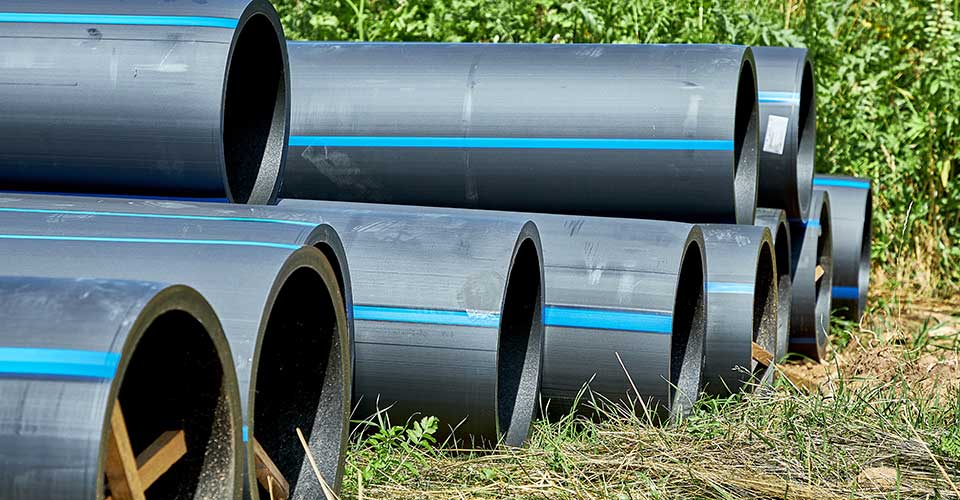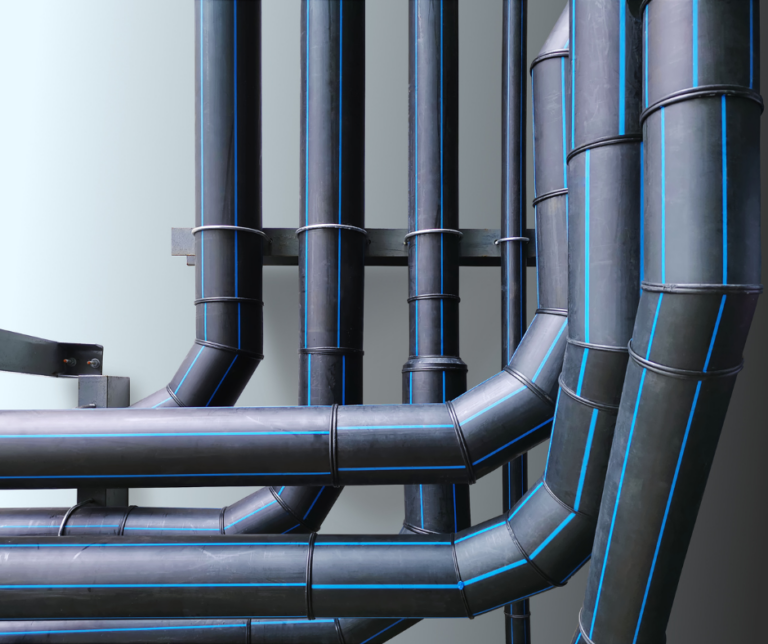How American Plastics HDPE Pipe Manufacturing Maintains Sustainability
Wiki Article
Explore the Manufacturing Process Behind High-Quality HDPE Pipeline and Its Applications
The production procedure of top notch HDPE pipes is complex and methodical. It begins with the selection of raw materials that enhance performance. Following this, ethylene undertakes polymerization to develop resin, which is after that formed via extrusion. Quality assurance is paramount, making certain that the last item satisfies rigorous criteria. However, the trip of HDPE pipelines does not end with production. Their applications across various markets expose a more comprehensive significance worth analyzing.Comprehending HDPE: Characteristics and Advantages

High-density polyethylene (HDPE) is a functional polycarbonate recognized for its longevity and resistance to various ecological aspects. This product shows superb tensile toughness, making it suitable for requiring applications. Its low-density structure adds to a lightweight item, assisting in simplicity of managing and installation. HDPE additionally showcases exceptional resistance to chemicals, which reduces destruction when subjected to harsh materials.
The product's reduced dampness absorption additionally enhances its long life, making it suitable for use in pipes and storage space tanks. In addition, HDPE is immune to ultraviolet (UV) radiation, making certain that items keep their integrity also when exposed to sunlight. Moreover, its adaptability permits the production of elaborate forms without compromising strength. The eco-friendly nature of HDPE, usually obtained from recycled products, adds to its allure, promoting lasting methods in manufacturing. Overall, these residential or commercial properties and advantages make HDPE a recommended option for various commercial and consumer applications.
Resources Selection for HDPE Production
The choice of raw products for HDPE production is vital to confirm the last product satisfies the preferred specifications and top quality criteria. High-density polyethylene (HDPE) is primarily produced from polymerized ethylene, originated from nonrenewable fuel sources such as natural gas or petroleum. The quality of these feedstocks considerably affects the mechanical and thermal homes of the final HDPE.Ingredients likewise play a substantial function in enhancing HDPE's efficiency, consisting of antioxidants, UV stabilizers, and colorants, which enhance toughness and resistance to environmental elements. The selection process have to take into consideration not just the chemical structure of the raw materials but additionally their handling qualities to guarantee reliable production.
The sourcing of raw products should focus on sustainability and conformity with ecological regulations, as accountable techniques are critical in today's market. Ultimately, careful basic material option lays the foundation for generating high-quality HDPE pipelines suitable for varied applications.
The Extrusion Process: Shaping HDPE Pipeline
The extrusion process plays a vital role in forming HDPE pipes, starting with meticulous material prep work techniques that assure optimal circulation and uniformity. Equally crucial is the layout of the die, which directly influences the last dimensions and surface area top quality of the pipeline. With each other, these elements contribute substantially to the performance and quality of HDPE pipe manufacturing.Product Prep Work Techniques
Effective manufacturing of HDPE pipelines begins with precise product prep work methods, specifically the extrusion process. During this phase, high-density polyethylene material is initial dried to remove dampness, making certain suitable circulation qualities. The material is after that fed into the extruder, where it goes through heating and melting, transforming into a thick state. This home heating process is thoroughly regulated to preserve the material's honesty and efficiency. The liquified HDPE is forced through a die, shaping it into a constant pipe form. Proper temperature level management throughout extrusion is necessary, as it straight influences the product's residential properties and the end product top quality. When formed, the HDPE pipe is cooled down and reduced to specified sizes, all set for subsequent handling and applications.Die Style Value
Precision in die design plays an essential duty in the extrusion process of HDPE pipelines. The die acts as the final shaping tool, straight influencing the pipeline's dimensions, wall thickness, and surface finish. A properly designed die assurances consistent product circulation, reducing defects such as abnormalities and vulnerable points. The geometry of the die must be maximized to fit the particular homes of HDPE, including its thickness and thermal habits throughout extrusion. In addition, the cooling price of the material as it travels through the die can markedly influence the pipe's architectural stability. Investing in advanced die innovation is essential for manufacturers aiming to produce high-quality HDPE pipelines that meet industry requirements and consumer expectations.Quality Assurance Procedures in HDPE Production
Various variables influence the top quality of HDPE pipe manufacturing, reliable high quality control measures are crucial to assure consistency and dependability in the final product (Midland TX HDPE Pipe Fittings in Stock). Trick quality control practices consist of strenuous product inspection, verifying that the raw polyethylene satisfies well established requirements for purity and thickness. Throughout the extrusion process, parameters such as temperature, pressure, and cooling time are carefully kept track of to preserve dimensional precision and structural honestyFurthermore, post-production testing is necessary; manufacturers commonly perform hydrostatic examinations to analyze the pipe's stamina and resistance to stress. Visual examinations for surface area problems further boost quality control. Accreditation from relevant criteria organizations, like ASTM or ISO, provides an added layer of credibility. By applying these comprehensive quality control actions, makers can reduce flaws, enhance performance, and ensure that the HDPE pipes satisfy the certain requirements of numerous applications, ultimately causing customer satisfaction and count on the product.
Applications of HDPE Pipe Throughout Industries
HDPE pipelines are utilized throughout various sectors as a result of their sturdiness and convenience. In water circulation systems, they assure efficient delivery, while in wastewater administration, they supply trustworthy services for waste transport. In addition, agricultural irrigation networks profit from HDPE's resistance to corrosion and versatility, making it an excellent option for modern farming techniques.
Water Distribution Solutions
A considerable variety of industries count on high-density polyethylene (HDPE) pipes for efficient water circulation systems. Recognized for their resilience and resistance to corrosion, HDPE pipes are widely made use of in municipal supply of water networks, farming watering, and industrial applications. Their lightweight nature promotes easy handling and setup, lowering labor costs and time. Furthermore, HDPE pipelines can fit numerous pressure degrees, making them ideal for both low and high-pressure systems. Midland TX HDPE Pipe Fittings in Stock. The versatility of the product permits smooth assimilation into existing facilities, decreasing the need for considerable excavation. Furthermore, HDPE's resistance to chemical seeping guarantees that the water provided remains risk-free and tidy, making it a perfect option for preserving the top quality of drinkable water across different industriesWastewater Monitoring Solutions
Effective water distribution systems additionally pave the method for innovative wastewater administration remedies, where high-density polyethylene (HDPE) pipes play a substantial role. Prominent for their longevity and resistance to rust, HDPE pipelines are excellent for moving wastewater in different settings. Their flexibility permits very easy installation in complicated settings, minimizing the requirement for extensive excavation. In addition, HDPE's smooth interior surface reduces rubbing, improving flow rates and efficiency. These pipes are also resistant to chemical leaching, go to website making sure that impurities do not compromise the surrounding environment. Industries, towns, and treatment facilities increasingly count on HDPE pipes for their reliability and longevity, making them a recommended selection for modern-day wastewater monitoring systems. This flexibility emphasizes the important importance of HDPE pipelines throughout many applications.Agricultural Watering Networks
Agricultural watering networks profit substantially from the use of high-density polyethylene (HDPE) pipes, which offer effective and trustworthy water shipment to crops. HDPE pipes are light-weight, making them simple to carry and set up, while their versatility enables various configurations in varied terrains. These pipes demonstrate superb resistance to rust, chemicals, and UV radiation, guaranteeing toughness in extreme agricultural settings. In addition, their smooth interior surface minimizes friction loss, optimizing water flow and lowering power expenses related to pumping. The durability of HDPE pipes, often going beyond half a century, adds to decrease upkeep and substitute expenses. As a result, farmers significantly rely upon HDPE pipes to enhance watering efficiency and promote sustainable agricultural practices, inevitably causing boosted crop returns and source conservation.Future Fads in HDPE Pipe Modern Technology
As the demand for sustainable and efficient framework expands, innovations in HDPE pipeline technology are positioned to change various sectors. Arising fads consist of the assimilation of smart modern technologies, such as sensors and IoT abilities, which help with real-time tracking of pipeline problems, reducing maintenance costs and stopping leaks. Furthermore, the development of innovative manufacturing strategies, such as 3D printing, is making it possible for the manufacturing of facility, personalized pipe designs that provide to particular job needs.The focus on recycling and round economic situation practices is driving the innovation of HDPE pipes made from recycled materials, enhancing sustainability. Enhanced jointing methods, such as electro-fusion and mechanical fittings, are also improving installation effectiveness and dependability. The expanding focus on ecological laws is pressing suppliers to take on greener manufacturing procedures, making certain that HDPE pipelines not just satisfy industry standards but also foster a more sustainable future for facilities development.
Regularly Asked Inquiries
Just How Does HDPE Contrast to Various Other Plastic Products?
HDPE exceeds numerous other plastic products pertaining to durability, chemical resistance, and versatility. Its view it low thickness and high tensile stamina make it perfect for various applications, often exceeding alternatives in both efficiency and durability.What Are the Environmental Influences of HDPE Manufacturing?
The environmental impacts of HDPE production consist of greenhouse gas discharges, power consumption, and prospective contamination from making procedures. Additionally, inappropriate disposal can result in dirt visit the website and water contamination, increasing problems regarding long-lasting environmental impacts.Can HDPE Pipeline Be Reused?
Yes, HDPE pipelines can be recycled. Numerous facilities accept used HDPE for processing, changing it into new products. This reusing contributes to sustainability initiatives, lowering plastic waste while preserving resources and power in the manufacturing cycle.What Is the Lifespan of HDPE Water Lines?

Just How Do Temperature Variants Impact HDPE Pipe Performance?
Temperature variations considerably impact HDPE pipeline efficiency, impacting versatility and toughness. High temperatures can cause softening, while low temperatures may cause brittleness, inevitably affecting the pipe's longevity and suitability for different applications in varied environments.Report this wiki page